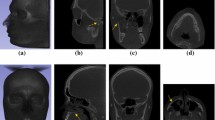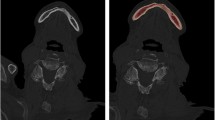Abstract
Objectives
To segment the mandible from cone-beam computed tomography (CBCT) images efficiently and accurately for the 3D mandible model is essential for subsequent research and diagnosis.
Methods
This paper proposes a local region-based variational region growing algorithm, which integrates local region and shape prior to segment the mandible accurately. Firstly, we select initial seeds in the CBCT image and then calculate candidate point sets and the local region energy function of each point. If a point reduces the energy, it is selected to be a pixel of the foreground region. By multiple iterations, the mandible segmentation of the slice can be obtained. Secondly, the segmented result of the previous slice is adopted as the shape prior to the next slice until all of the slices in CBCT are segmented. At last, the final mandible model is reconstructed by the Marching Cubes algorithm.
Results
The experimental results on CBCT datasets illustrate the LRVRG algorithm can obtain satisfied 3D mandible models from CBCT images and it can solve the fuzzy problem effectively. Furthermore, quantitative comparisons with other methods demonstrate the proposed method achieves the state-of-the-art performance in mandible segmentation.
Conclusions
Experiments demonstrate that our method is efficient and accurate for the mandible model segmentation.













Similar content being viewed by others
References
Mozzo P, Procacci C, Tacconi A, Martini PT, Andreis IA. A new volumetric CT machine for dental imaging based on the cone-beam technique: preliminary results. Eur Radiol. 1998;8(9):1558–64.
Spampinato C, Pino C, Giordano D, et al. Automatic 3D segmentation of mandible for assessment of facial asymmetry[C]. IEEE International Symposium on Medical Measurements and Applications Proceedings. IEEE. 2012;2012:1–4.
Gollmer S T, Buzug T M. Fully automatic shape constrained mandible segmentation from cone-beam CT data[C]//2012 9th IEEE international symposium on biomedical imaging (ISBI). IEEE, 2012;1272–1275.
Pohle R, Toennies K D. Segmentation of medical images using adaptive region growing[C]//Medical Imaging 2001: Image Processing. International Society for Optics and Photonics, 2001;4322:1337–1346.
Yan M, Guo J, Tian W, et al. Symmetric convolutional neural network for mandible segmentation. Knowledge-Based Systems. 2018;159:63–71.
Shen D, Ip HHS. A Hopfield neural network for adaptive image segmentation: An active surface paradigm. Pattern Recognition Letters. 1997;18(1):37–48.
Zhan Y, Shen D. Automated segmentation of 3D US prostate images using statistical texture-based matching method[C]//International Conference on Medical Image Computing and Computer-Assisted Intervention. Springer, Berlin, Heidelberg, 2003;688–696.
Loubele M, Bogaerts R, Van Dijck E, et al. Comparison between effective radiation dose of CBCT and MSCT scanners for dentomaxillofacial applications[J]. Eur J Radiol. 2009;71(3):461–8.
Barandiaran I, Macía I, Berckmann E, et al. An automatic segmentation and reconstruction of mandibular structures from CT-data[C]//International Conference on Intelligent Data Engineering and Automated Learning. Springer, Berlin, Heidelberg, 2009;649–655.
Lu S, Yu X, Gai-Xian S, et al. Study of outer contour extraction based on mandible CBCT image[J]. Laser J. 2013;34(6):101–2.
Tan PY, Chen JH, Li P, Guo JX, Tang W, Long J, Liu L, Tian WD. Improving Threshold Segmentation in 3D Reconstruction of Mandible CT Image[J]. Sichuan Da Xue Xue Bao Yi Xue Ban. 2015;46(3):458–62.
Kainmueller D, Lamecker H, Seim H, et al. Automatic extraction of mandibular nerve and bone from cone-beam CT data[C]//International Conference on Medical Image Computing and Computer-Assisted Intervention. Springer, Berlin, Heidelberg, 2009;76–83.
Wang L, Chen KC, Gao Y, et al. Automated bone segmentation from dental CBCT images using patch-based sparse representation and convex optimization[J]. Med Phys. 2014;41(4):043503.
Brandariz M, Barreira N, Penedo M G, et al. Automatic segmentation of the mandible in cone-beam computer tomography images[C]//2014 IEEE 27th International Symposium on Computer-Based Medical Systems. IEEE, 2014;467–468.
Linares OC, Bianchi J, Raveli D, et al. Mandible and skull segmentation in cone beam computed tomography using super-voxels and graph clustering[J]. The Visual Computer. 2019;35(10):1461–74.
Jean-Loic R, Chantal R M, Christophe O, et al. Variational region growing[C]//International Conference on Computer Vision Theory and Applications. SCITEPRESS, 2009;1:166–171.
Lorensen WE, Cline HE. Marching cubes: A high resolution 3D surface construction algorithm. ACM siggraph computer graphics. 1987;21(4):163–9.
Heimann T, Ginneken BV, Styner MA, et al. Comparison and Evaluation of Methods for Liver Segmentation From CT Datasets[J]. IEEE Trans Med Imaging. 2009;28(8):1251–65.
Li CM, Xu CY, Gui CF, et al. Distance regularized level set evolution and its application to image segmentation[J]. IEEE Trans Image Process. 2010;19(12):3243–54.
Acknowledgement
This work was funded by the National Key R&D Program of China (Grant No. 2019YFC17902) and the National Natural Science Foundation of China (Grant No. 61672452, 81827804, 61972342, 81970978). All procedures followed were in accordance with the ethical standards of the responsible committee on human experimentation (institutional and national) and with the Helsinki Declaration of 1975, as revised in 2008 (5). Informed consent was obtained from all patients for being included in the study. All authors have no conflict of interest. This article does not contain any studies with animal subjects performed by any of the authors.
Author information
Authors and Affiliations
Corresponding authors
Additional information
Publisher's Note
Springer Nature remains neutral with regard to jurisdictional claims in published maps and institutional affiliations.
Supplementary Information
Below is the link to the electronic supplementary material.
Supplementary file1 (MP4 3667 KB)
Rights and permissions
About this article
Cite this article
Jiang, Y., Qian, J., Lu, S. et al. LRVRG: a local region-based variational region growing algorithm for fast mandible segmentation from CBCT images. Oral Radiol 37, 631–640 (2021). https://doi.org/10.1007/s11282-020-00503-5
Received:
Accepted:
Published:
Issue Date:
DOI: https://doi.org/10.1007/s11282-020-00503-5




